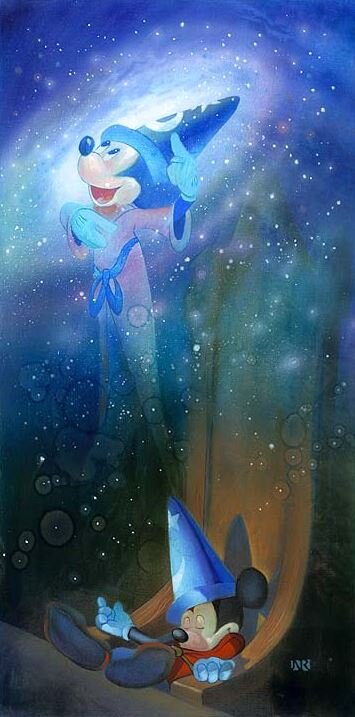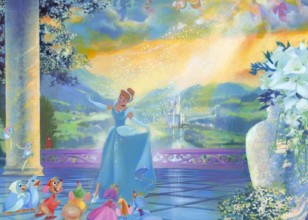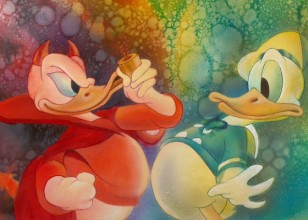Product Description
This The Flight To Fantasy Mickey Sorcerer's Apprentice Giclee on Canvas by John Rowe has the dreamlike quality of the Sorcerer's Apprentice segment of Fantasia that captures the imagination of fans.
The Flight to Fantasy is signed by John Rowe and comes shipped in a tube.
Throughout the earlier years, Mickey's design bore heavy resemblance to Oswald, save for the ears, nose, and tail. Ub Iwerks designed Mickey's body out of circles in order to make the character simple to animate. Disney employees John Hench and Marc Davis believed that this design was part of Mickey's success as it made him more dynamic and appealing to audiences.
Mickey's circular design is most noticeable in his ears. In animation in the 1940s, Mickey's ears were animated in a more realistic perspective. Later, they were drawn to always appear circular no matter which way Mickey was facing. This made Mickey easily recognizable to audiences and made his ears an unofficial personal trademark. The circular rule later created a dilemma for toy creators who had to recreate a three-dimensional Mickey.
In 1938, animator Fred Moore redesigned Mickey's body away from its circular design to a pear-shaped design. Colleague Ward Kimball praised Moore for being the first animator to break from Mickey's "rubber hose, round circle" design. Although Moore himself was nervous at first about changing Mickey, Walt Disney liked the new design and told Moore "that's the way I want Mickey to be drawn from now on."
Each of Mickey's hands has only three fingers and a thumb. Disney said that this was both an artistic and financial decision, explaining "Artistically five digits are too many for a mouse. His hand would look like a bunch of bananas. Financially, not having an extra finger in each of 45,000 drawings that make up a six and one-half minute short has saved the Studio millions." In the film The Opry House (1929), Mickey was first given white gloves as a way of contrasting his naturally black hands against his black body. The use of white gloves would prove to be an influential design for cartoon characters, particularly with later Disney characters, but also with non-Disney characters such as Bugs Bunny, Woody Woodpecker, Mighty Mouse, and Mario.
Mickey's eyes, as drawn in Plane Crazy and The Gallopin' Gaucho, were large and white with black outlines. In Steamboat Willie, the bottom portion of the black outlines was removed, although the upper edges still contrasted with his head. Mickey's eyes were later re-imagined as only consisting of the small black dots which were originally his pupils, while what were the upper edges of his eyes became a hairline. This is evident only when Mickey blinks. Fred Moore later redesigned the eyes to be small white eyes with pupils and gave his face a Caucasian skin tone instead of plain white. This new Mickey first appeared in 1938 on the cover of a party program, and in animation the following year with the release of The Pointer. Mickey is sometimes given eyebrows as seen in The Simple Things (1953) and in the comic strip, although he does not have eyebrows in his most recent appearances.
Some of Mickey's early appearance, particularly the gloves, and facial characteristics, evolved from blackface caricatures used in minstrel shows.
Besides Mickey's gloves and shoes, he typically wears only a pair of shorts with two large buttons in the front. Before Mickey was seen regularly in color animation, Mickey's shorts were either red or a dull blue-green. With the advent of Mickey's color films, the shorts were always red. When Mickey is not wearing his red shorts, he is often still wearing red clothing such as a red bandmaster coat (The Band Concert, The Mickey Mouse Club), red overalls (Clock Cleaners, Boat Builders), a red cloak (Fantasia, Fun and Fancy Free), a red coat (Squatter's Rights, Mickey's Christmas Carol), or a red shirt (Mickey Down Under, The Simple Things)
About John Rowe:
John received his training at Art Center College of Design and began his career as an illustrator. His paintings have appeared on movie posters, books, billboards, magazines and advertisements throughout the country and around the world. Seeking an additional outlet for his creative vision, John began his Horse Series, bringing together equine beauty and power with emotions of the human spirit. When the publishers of Walter Farley's The Black Stallion saw John's work, they were inspired to re-issue this classic series, commissioning 24 new paintings by John for the covers. He has also been part of the rerelease of the books of Marguerite Henry. He is also responsible for some wonderful finished movie posters, including for the movie "Miracle".
"My artwork is meant to recall the beauty, majesty and mystery of the life we live, and the world we live it in. Painting the small delicacy of the light on a child's face, or the overwhelming power and grace of the sky at sunrise, is my attempt to capture some of that wonder. Through my work I hope to remind you and myself how truly wonderful, complex, and vivid life is. Whether we are looking into the eyes of someone we love, or struggling just to breath, life is a priceless gift." John has maintained a successful painting career for nearly 20 years. His studio is in La Canada California, where he lived with his wife and two children. He received his art training at Art Center College of Design, and has worked with clients throughout the United States and around the world. His limited editions of interpretive Disney art are some of the fastest selling images at Disney World and Disneyland.




